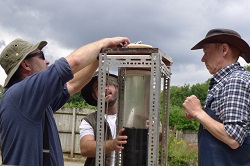An accurate account of damage done by brominated flame retardants
Toxic effects associated with BFR exposure include diabetes, neurobehavioral and developmental disorders, cancer, reproductive health effects and alteration in thyroid function. To provide academia, environmental agencies, regulators and industry with reliable information on the effects of BFRs, the EU-funded ELUTE project has harnessed recent advances in analytical instrumentation. The overall aim was to collect information on how these persistent organic bromides and other chemicals can be used sustainably. Much of the research took into account that some BFRs such as polybrominated diphenylethers (PBDEs) have been phased out as it is important to distinguish between these legacy compounds and new BFRs. Accuracy and relevance of instrumentation Researchers used a hand-held X-ray fluorescence (XRF) spectrometer to accurately measure the bromine content in waste material. One limitation was that a high bromine level was not always due to the presence of a now restricted BFR. ‘A high bromine level does not necessarily mean that that article exceeds the maximum permissible concentration for a restricted-use BFR. Instead, we have shown that “false positives” (i.e. where a bromine concentration above the limit value is due to a non-restricted BFR) do occur,’ explains Professor Stuart Harrad, project coordinator. This knowledge will help regulators develop pragmatic approaches to prevent articles containing restricted BFRs from entering the waste stream. Practically speaking, a conservative approach may be taken whereby articles exceeding the limit for bromine are assumed to exceed the limit for restricted BFRs. ELUTE conducted a trial to determine if increased manufacture and use of BFRs has led to increased environmental levels of such as PBDEs. ‘We used a larger than normal diameter corer named Big Ben after its designer. This is crucial as the state-of-the-art techniques required to determine concentrations of legacy brominated dioxins and furans at the trace levels they are found at, require as much sample as possible to give reliable data,’ comments Prof. Harrad. Environmental impact and effects on development The mixture of legacy BFRs and the hundreds of emerging BFRs to replace them presents a complex picture for determining effects of BFRs. In response, ELUTE has generated valuable first insights into the human metabolism of one of the principal BFRs currently in use. ‘The team has generated baseline data on the presence in sediments of the River Thames of BFRs that are emerging as replacements for recently banned BFRs,’ informs Prof. Harrad. To complicate the picture even further, metabolism and degradation of BFRs creates new molecules. In vitro methods developed by the project have provided the first data on human metabolism of a key BFR, a form of tetrabromoethylcyclohexane (TBECH) that causes developmental disturbances in zebrafish. Furthermore, TBECH changes androgen receptor regulation in response to mutations associated with prostate cancer. Commenting on the significance of their work, Prof. Harrad points out, ‘Our data on metabolism of TBECH is important, as it allows us to predict concentrations in human blood that will arise as a result of our exposure to it.’ Training for future BFR research and recycling applications ELUTE is a Marie Curie Initial Training Network programme that was designed to provide a knowledge base as well as experience to four early stage researchers. In addition to developing their transferable skills for future careers, their studies will ensure a sustainable future research platform for investigation into dynamic areas such as BFRs. Project success is reflected in the two patent applications in the field of analytical chemistry instrumentation by one of the ESRs, who is now employed by ThermoFisher Scientific in Bremen, the non-academic partner in ELUTE. Applications of the project results include use of the hand-held XRF that has been fed into a project the team were conducting for the Environmental Protection Agency of Ireland. Of extreme significance is the link with recycling materials containing BFRs. ‘We are also working on new projects with a major UK plastic recycler to evaluate approaches that will allow waste plastics that are currently unrecyclable because their BFR content exceeds legislative limits to be made into sustainable and commercially viable products,’ states Prof. Harrad. ‘This will help the development of Europe’s circular economy.’







